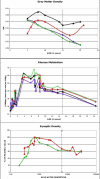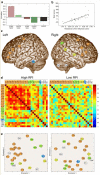Why do many psychiatric disorders emerge during adolescence?
- PMID: 19002191
- PMCID: PMC2762785
- DOI: 10.1038/nrn2513
Why do many psychiatric disorders emerge during adolescence?
Abstract
The peak age of onset for many psychiatric disorders is adolescence, a time of remarkable physical and behavioural changes. The processes in the brain that underlie these behavioural changes have been the subject of recent investigations. What do we know about the maturation of the human brain during adolescence? Do structural changes in the cerebral cortex reflect synaptic pruning? Are increases in white-matter volume driven by myelination? Is the adolescent brain more or less sensitive to reward? Finding answers to these questions might enable us to further our understanding of mental health during adolescence.
Figures




Similar articles
-
Brain structural and functional changes in adolescents with psychiatric disorders.Int J Adolesc Med Health. 2013;25(3):245-56. doi: 10.1515/ijamh-2013-0058. Int J Adolesc Med Health. 2013. PMID: 23828425 Free PMC article. Review.
-
Mapping brain maturation and cognitive development during adolescence.Trends Cogn Sci. 2005 Feb;9(2):60-8. doi: 10.1016/j.tics.2004.12.008. Trends Cogn Sci. 2005. PMID: 15668098 Review.
-
Alcohol, psychological dysregulation, and adolescent brain development.Alcohol Clin Exp Res. 2008 Mar;32(3):375-85. doi: 10.1111/j.1530-0277.2007.00601.x. Epub 2008 Jan 30. Alcohol Clin Exp Res. 2008. PMID: 18241320 Review.
-
GABAergic contributions to alcohol responsivity during adolescence: insights from preclinical and clinical studies.Pharmacol Ther. 2014 Aug;143(2):197-216. doi: 10.1016/j.pharmthera.2014.03.001. Epub 2014 Mar 11. Pharmacol Ther. 2014. PMID: 24631274 Free PMC article. Review.
-
Sex differences in brain maturation during childhood and adolescence.Cereb Cortex. 2001 Jun;11(6):552-7. doi: 10.1093/cercor/11.6.552. Cereb Cortex. 2001. PMID: 11375916
Cited by
-
Prefrontal parvalbumin interneurons mediate CRHR1-dependent early-life stress-induced cognitive deficits in adolescent male mice.Mol Psychiatry. 2024 Nov 22. doi: 10.1038/s41380-024-02845-6. Online ahead of print. Mol Psychiatry. 2024. PMID: 39578519
-
A temporal cortex cell atlas highlights gene expression dynamics during human brain maturation.Nat Genet. 2024 Nov 20. doi: 10.1038/s41588-024-01990-6. Online ahead of print. Nat Genet. 2024. PMID: 39567748
-
Social Learning and Preferences in Adolescents With Conduct Problems and Varying Levels of Callous-Unemotional Traits.JAACAP Open. 2024 Jan 12;2(2):79-89. doi: 10.1016/j.jaacop.2023.12.008. eCollection 2024 Jun. JAACAP Open. 2024. PMID: 39554205 Free PMC article.
-
Brain functional connectivity, but not neuroanatomy, captures the interrelationship between sex and gender in preadolescents.bioRxiv [Preprint]. 2024 Nov 1:2024.10.31.621379. doi: 10.1101/2024.10.31.621379. bioRxiv. 2024. PMID: 39554185 Free PMC article. Preprint.
-
Somatomotor disconnection links sleep duration with socioeconomic context, screen time, cognition, and psychopathology.bioRxiv [Preprint]. 2024 Oct 29:2024.10.29.620865. doi: 10.1101/2024.10.29.620865. bioRxiv. 2024. PMID: 39553993 Free PMC article. Preprint.
References
-
- Bushong S. Magnetic resonance imaging. 3rd ed Mosby Inc.; 2003.
-
- Roberts TP, Mikulis D. Neuro MR: principles. J Magn Reson Imaging. 2007 Oct;26(4):823–837. - PubMed
-
- Keshavan MS, Kapur S, Pettegrew JW. Magnetic resonance spectroscopy in psychiatry: Potential, pitfalls and promise. The American journal of psychiatry. 1991;148(8):976–985. - PubMed
-
- Logothetis NK, Pauls J, Augath M, Trinath T, Oeltermann A. Neurophysiological investigation of the basis of the fMRI signal. Nature. 2001 Jul 12;412(6843):150–157. - PubMed
-
- Lenroot RK, Giedd JN. Brain development in children and adolescents: insights from anatomical magnetic resonance imaging. Neuroscience and biobehavioral reviews. 2006;30(6):718–729. - PubMed
Publication types
MeSH terms
Grants and funding
LinkOut - more resources
Full Text Sources
Medical


